Factories, hospitals, and supply chains are drowning in data, yet only a fraction ever drives improvement. It’s no surprise that more executives want to know how to integrate AI into Lean Six Sigma projects to turn noise into insight.
The challenge isn’t the lack of data; it’s building the bridge between raw information and measurable impact.
In this article, we will:
- Outline steps to transform Lean Six Sigma with AI-powered DMAIC
- Show how to build AI-ready teams for Lean Six Sigma
AI-powered DMAIC: Practical steps for lean six sigma transformation
Integrating artificial intelligence into Lean Six Sigma projects requires a structured approach that balances technological capabilities with proven process improvement methodologies. The key lies in strategically implementing AI tools at each DMAIC phase while maintaining the human expertise that drives successful transformations.
Let's explore the essential steps to create a powerful synergy between AI and traditional Lean Six Sigma practices.
Step 1: Assess your current state and readiness
Before diving into AI implementation, organizations must conduct a comprehensive evaluation of their existing capabilities and infrastructure. This assessment forms the foundation for successful integration and helps identify potential roadblocks early in the process.
Evaluate your data infrastructure:
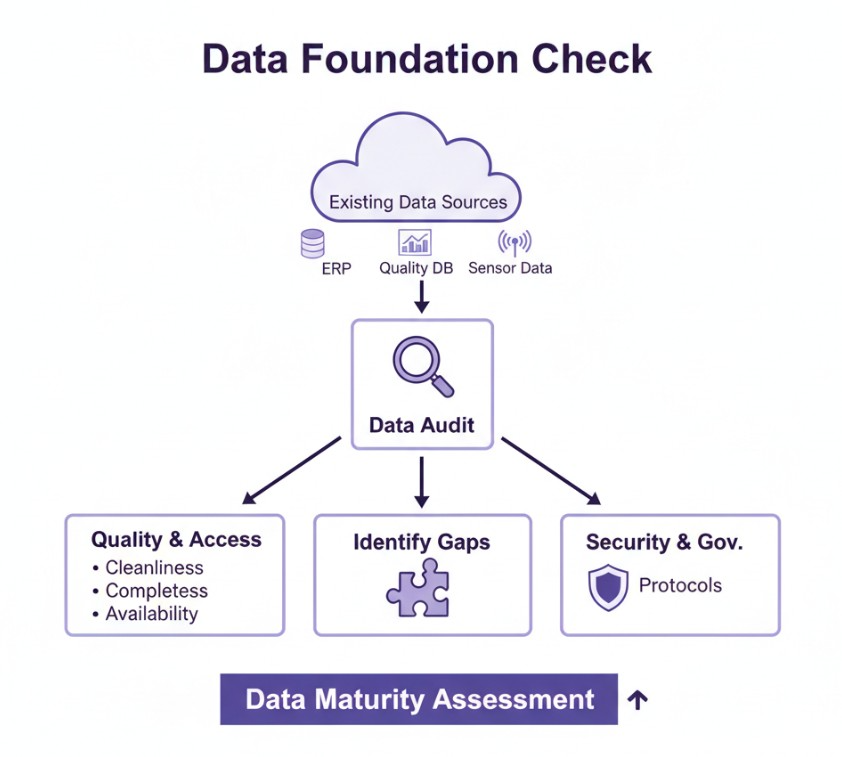
- Audit existing data sources (ERP systems, quality databases, sensor data)
- Assess data quality, completeness, and accessibility
- Identify data gaps that need to be addressed
- Ensure data governance and security protocols are in place
Pro tip: Start with a data maturity assessment using a standardized framework. Companies with scattered, low-quality data should focus on data consolidation before implementing AI solutions.
Determine organizational readiness:
- Evaluate team skills in both LSS and basic data analytics
- Assess leadership commitment and change management capabilities
- Review budget allocation for AI tools and training
- Identify internal champions and potential resistance points
Organizations with strong change management capabilities typically see 3x faster AI adoption rates compared to those without proper change infrastructure.
Step 2: Select the right AI tools for each DMAIC phase
The DMAIC methodology provides a perfect framework for strategic AI integration. Each phase offers unique opportunities to leverage artificial intelligence for enhanced problem-solving and process optimization.
Define phase AI integration:
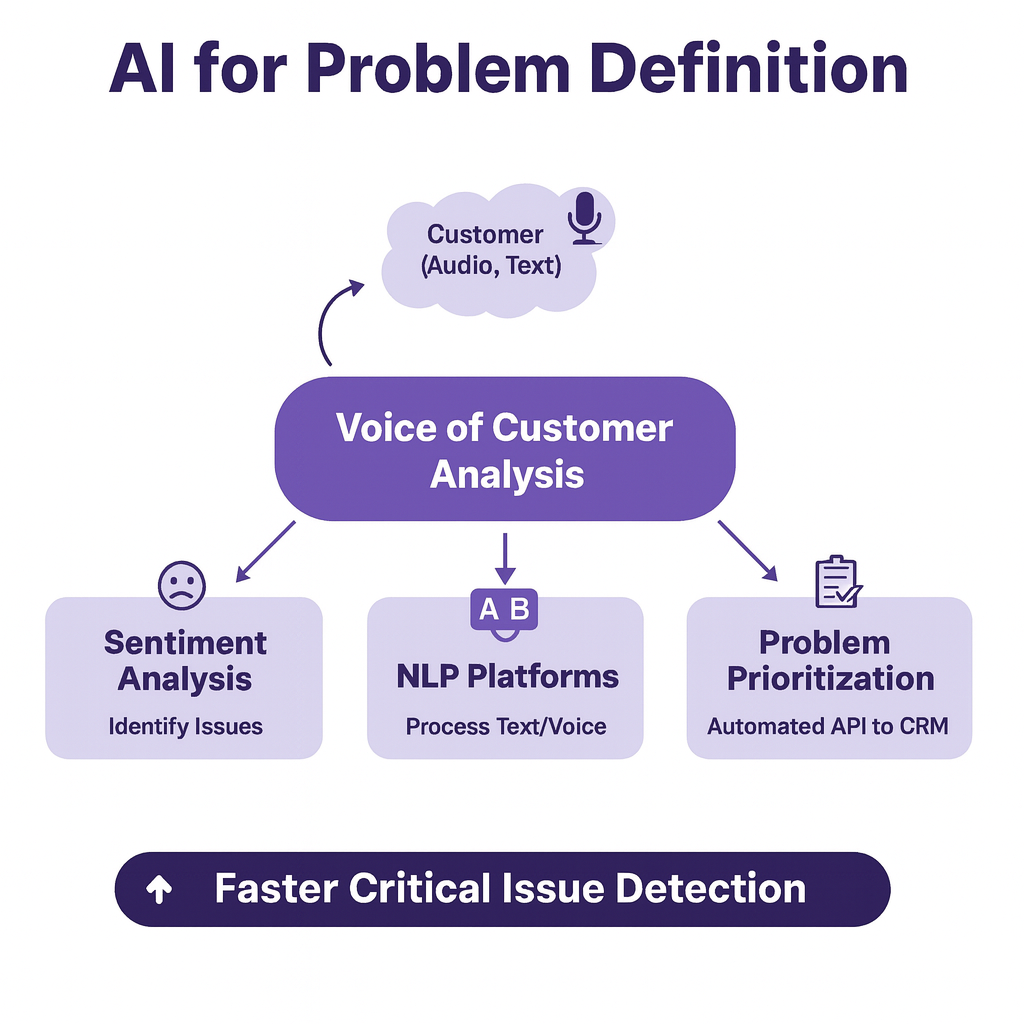
- Tool selection: Natural language processing (NLP) platforms for voice-of-customer analysis
- Implementation: Use sentiment analysis tools to process customer feedback and complaints
- Action steps: Integrate NLP APIs with CRM systems and set up automated problem prioritization
Modern NLP tools can process thousands of customer interactions in minutes, identifying critical issues that might take weeks to surface through traditional methods.
Measure phase AI integration:
- Tool selection: IoT sensors, computer vision systems, automated data collection platforms
- Implementation: Replace manual data collection with continuous monitoring systems
- Action steps: Install IoT sensors for real-time capture and implement computer vision for quality measurements
Real case: Eviden's computer vision solution delivered an 80% reduction in quality inspection lead time with over 85% accuracy for a German manufacturer, enabling automated inspection of products including communication devices, chipsets, and printed circuit boards.
Analyze phase AI integration:
- Tool selection: Machine learning platforms (Python/R with scikit-learn, TensorFlow)
- Implementation: Use AI algorithms to detect correlations and trends in massive datasets
- Action steps: Deploy clustering algorithms and implement anomaly detection models
The analyze phase benefits most from AI integration, with machine learning models capable of processing datasets 1000x larger than traditional statistical methods.
Improve phase AI integration:
- Tool selection: Simulation software with AI optimization, predictive modeling platforms
- Implementation: Use AI to test and optimize solutions before implementation
- Action steps: Create digital twins and deploy optimization algorithms
Pro tip: Start with simple optimization problems before tackling complex multi-variable scenarios. Success with smaller projects builds organizational confidence in AI capabilities.
Control phase AI integration:
- Tool selection: Real-time monitoring platforms, automated control systems
- Implementation: Set up AI-powered continuous monitoring and alerting
- Action steps: Configure automated SPC charts and implement predictive models
Companies using AI-powered control systems report 40% fewer process deviations compared to traditional monitoring approaches.
Step 3: Create your AI-LSS implementation roadmap
A phased approach ensures sustainable adoption while minimizing disruption to existing operations. This structured timeline allows for learning, adjustment, and gradual capability building.
Phase 1: Foundation building (months 1-3)
- Establish data infrastructure and governance protocols
- Train the core team on AI fundamentals and selected tools
- Select and procure AI software platforms
- Start with one pilot DMAIC project
Focus on data quality during this phase - poor data quality is the leading cause of AI project failures in lean six sigma implementations.
Phase 2: Pilot execution (months 4-6)
- Implement AI tools in selected DMAIC phases
- Collect performance metrics and lessons learned
- Refine algorithms based on initial results
- Demonstrate ROI to build organizational buy-in
Phase 3: Scaled implementation (months 7-12)
- Roll out AI-enhanced LSS to additional projects
- Establish centers of excellence for AI-LSS integration
- Create standardized templates and procedures
- Implement comprehensive training programs
Phase 4: Advanced integration (months 13+)
- Deploy fully automated DMAIC processes where appropriate
- Implement advanced AI capabilities like deep learning
- Create predictive improvement systems
- Establish continuous learning processes
Success metric: Organizations following this phased approach achieve 60% higher success rates compared to those attempting immediate full-scale implementation.
Step 4: Implement specific technology integration methods
Successful AI integration requires a robust technical infrastructure that seamlessly connects artificial intelligence tools with existing lean six sigma processes and organizational systems.
Data integration approach:
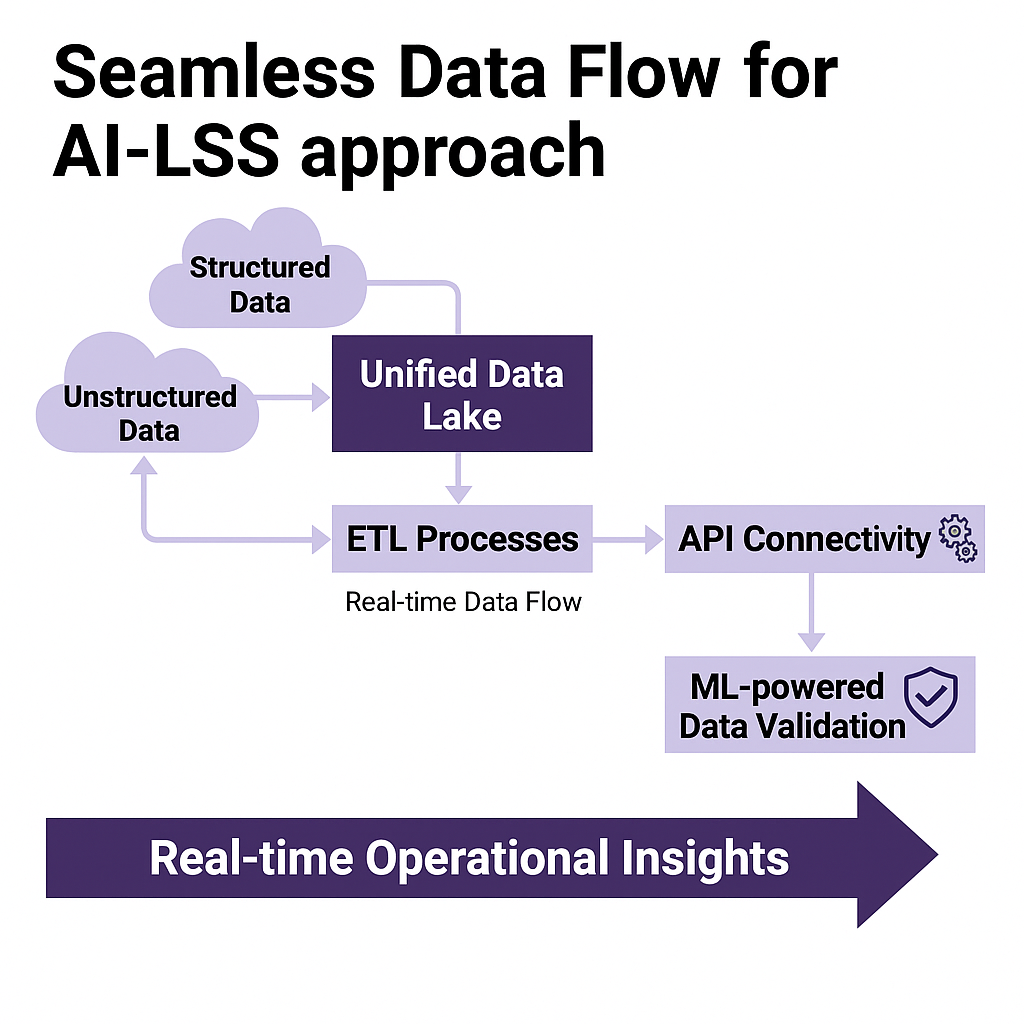
- Create unified data lakes combining structured and unstructured data
- Implement ETL processes for real-time data flow
- Establish APIs for seamless tool connectivity
- Set up machine learning-powered data validation
Real case: AMN Healthcare migrated to Snowflake data lake architecture and achieved a 75% reduction in data warehouse runtime while maintaining a 99.9% pipeline success rate, enabling real-time operational dashboards across multiple departments.
AI model development process:
- Define success metrics and KPIs for each application
- Collect and prepare training datasets specific to processes
- Select appropriate algorithms (supervised vs. unsupervised learning)
- Train, validate, and test models using historical data
- Implement model versioning and improvement cycles
Human-AI collaboration framework:
- Define roles where AI supports vs. replaces human decision-making
- Create validation checkpoints for AI recommendations
- Establish escalation procedures for low-confidence scenarios
- Implement feedback loops for continuous improvement
Pro tip: Maintain an 80/20 rule - let AI handle 80% of routine analysis while reserving complex decision-making for human experts.
Step 5: Measure success and optimize performance
Continuous measurement ensures AI investments deliver tangible value, and pairing the analysis with a value realization template highlights the benefits more effectively.
Key performance indicators:
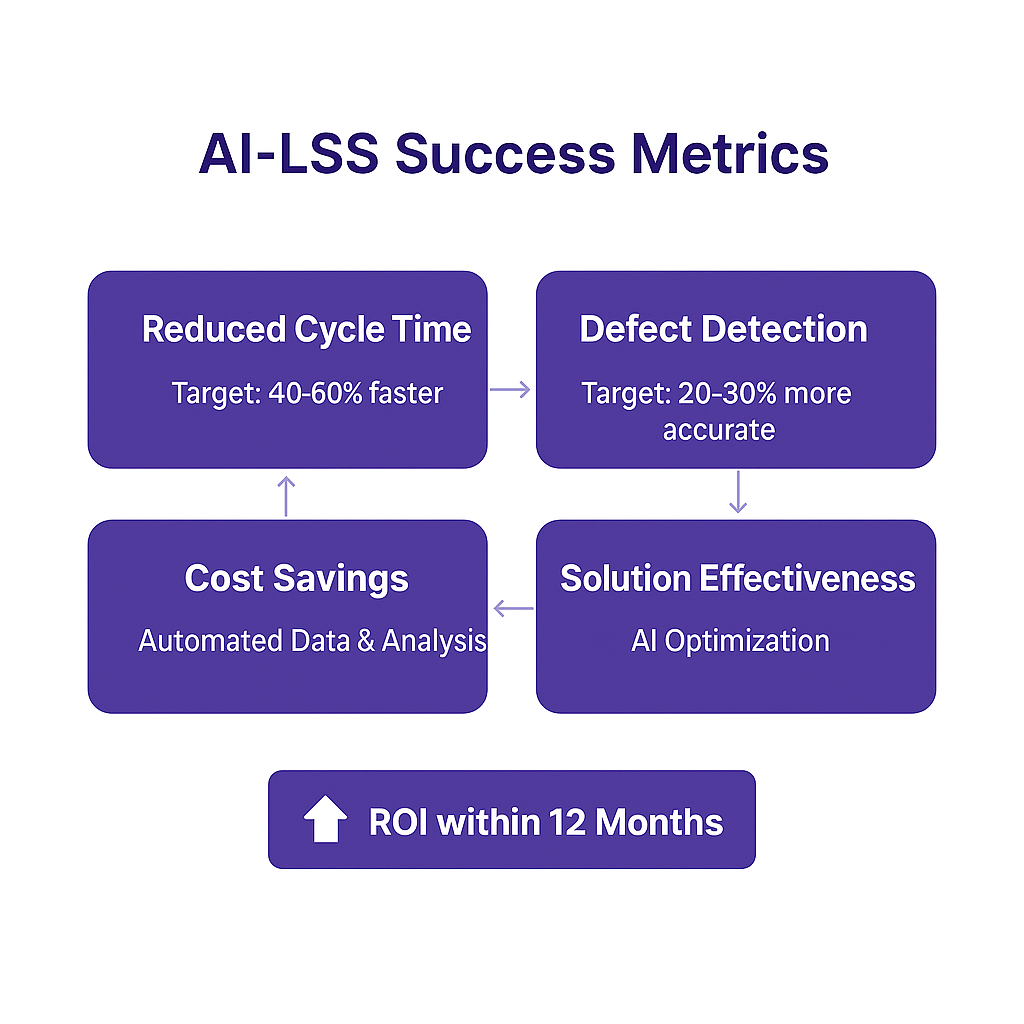
- Reduction in DMAIC cycle time (target: 40-60% improvement)
- Increase in defect detection accuracy (target: 20-30% improvement)
- Cost savings from automated data collection and analysis
- Improvement in solution effectiveness through AI optimization
Companies typically see ROI within 12 months when focusing on these core metrics during AI-LSS integration.
Common pitfalls to avoid:
- Don't automate broken processes - fix them first using traditional LSS
- Ensure data quality before implementing AI solutions
- Maintain human oversight and avoid complete AI dependence
- Start small with pilots before organization-wide scaling
- Invest in change management to overcome resistance
Critical insight: The most successful implementations treat AI as an enhancement tool rather than a replacement for lean six sigma methodology and human expertise.
Start with small pilot projects, prioritize data quality, and maintain human oversight to achieve sustainable AI-enhanced lean six sigma success.
Team transformation strategies: Building AI-ready lean six sigma capabilities
Successfully integrating AI into lean six sigma requires more than just technology; it demands a workforce transformation that combines traditional process improvement expertise with digital intelligence. Organizations must strategically develop their teams to bridge the gap between statistical analysis and artificial intelligence applications.
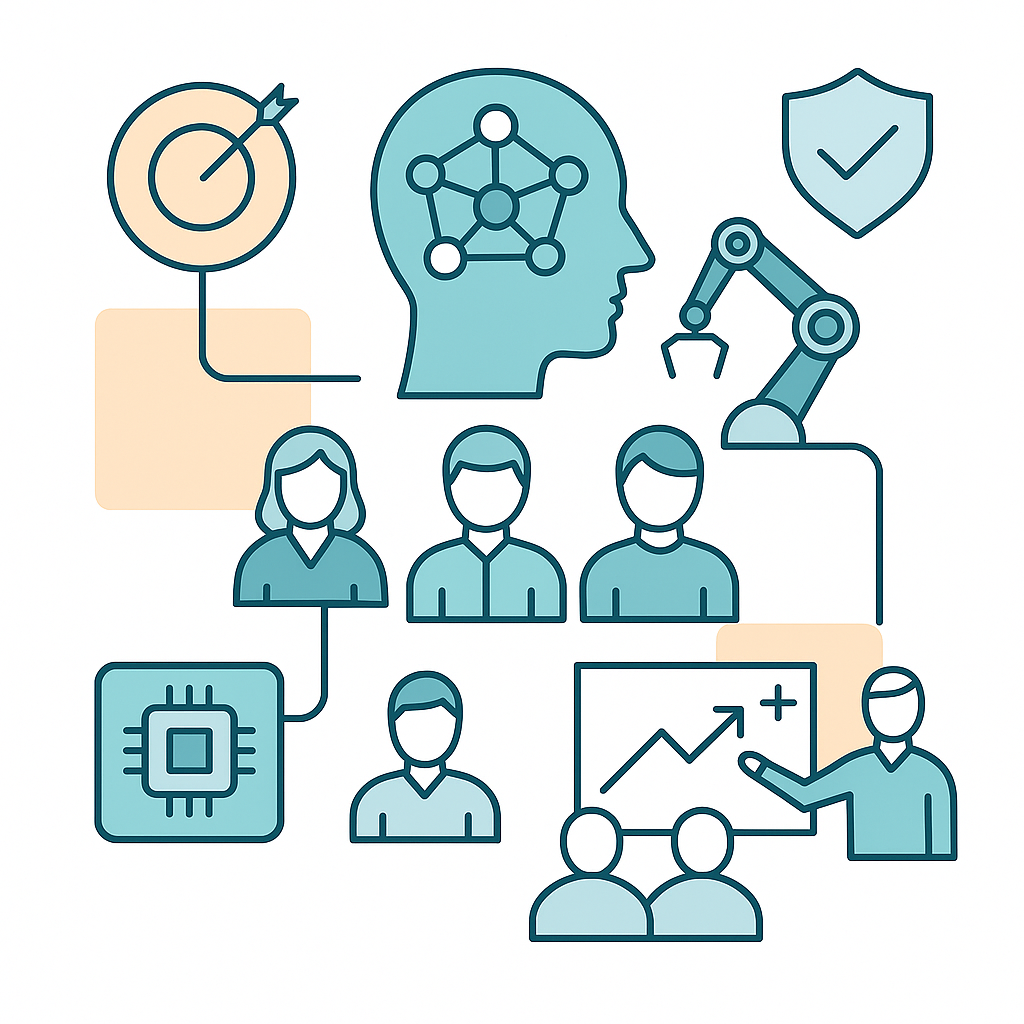
Skill requirements: Technical competencies needed for different roles
Modern AI-enhanced LSS teams need hybrid skill sets that span multiple disciplines. Each role requires specific technical competencies to maximize the synergy between human expertise and artificial intelligence capabilities.
Core competencies for AI-LSS professionals:
- Data analysis proficiency using Python, R, or advanced Excel
- Machine learning fundamentals and algorithm selection principles
- Statistical process control with AI enhancement capabilities
- Data visualization and dashboard creation skills
Key insight: Professionals don't need to become data scientists, but they must understand AI limitations and capabilities to make informed decisions about when and how to apply these tools.
Role-specific skill development:
- Black belts: Advanced analytics, predictive modeling, and AI tool integration
- Green belts: Basic machine learning concepts and automated data collection
- Process owners: AI performance monitoring and human-AI collaboration principles
- Team leaders: Change management and digital transformation leadership
Organizations investing in structured skill development see 70% higher success rates in AI-LSS implementations compared to those relying on ad-hoc training.
Training program design: Curriculum development for existing LSS professionals
Effective training programs build upon existing LSS knowledge while introducing AI concepts gradually. The curriculum should focus on practical applications rather than theoretical computer science principles.
Recommended training modules:
- AI fundamentals in the process improvement context
- Hands-on experience with user-friendly AI platforms
- Case studies showing successful AI-LSS integrations
- Practice sessions using real organizational data
Pro tip: Start with familiar problems and show how AI can enhance traditional DMAIC methods rather than replacing them entirely.
Implementation approach:
- Begin with 2-day intensive workshops covering AI basics
- Follow with monthly practice sessions using actual projects
- Create mentorship programs pairing AI-experienced professionals with traditional LSS experts
- Establish communities of practice for ongoing knowledge sharing
Companies using blended learning approaches achieve 85% higher skill retention rates compared to traditional classroom-only training.
Certification pathways: Available programs and their value proposition
Several organizations now offer AI-enhanced LSS certifications that validate competencies in both traditional process improvement and artificial intelligence applications.
Leading certification programs:
- ASQ's AI for Quality certification combines Six Sigma with machine learning
- IASSC's Digital Lean Six Sigma programs featuring predictive analytics
- University partnerships offering LSS-AI hybrid credentials
- Vendor-specific certifications for popular AI platforms
Value proposition: Certified professionals command 25-40% higher salaries and demonstrate credible expertise in this emerging field.
Change management strategies: Overcoming resistance to AI adoption
Resistance to AI adoption often stems from fear of job displacement rather than technical concerns. Successful change management addresses these emotional and practical barriers systematically.
Proven resistance mitigation strategies:
- Emphasize AI as an enhancement tool rather than a replacement technology
- Share success stories showing career advancement opportunities
- Provide hands-on experiences with user-friendly AI tools
- Create gradual transition periods with adequate support
Critical success factor: Leadership must consistently communicate that human expertise remains essential while AI handles routine analytical tasks.
Invest in comprehensive team development, focus on practical skill building, and maintain transparent communication to create AI-ready lean six sigma capabilities that drive organizational success.
Elevate Lean Six Sigma from discipline to intelligence
Integrating AI into Lean Six Sigma is no longer optional; it’s the path to faster results, smarter decisions, and sustainable efficiency. From AI-powered DMAIC to team transformation and continuous optimization, the opportunities are clear: data becomes insight, and insight becomes measurable impact.
The key is to start small, focus on data quality, and scale with confidence. By doing so, organizations can elevate Lean Six Sigma from a disciplined framework into an intelligent engine for lasting competitive advantage.


%20(1).jpg)
_light%201.png)





